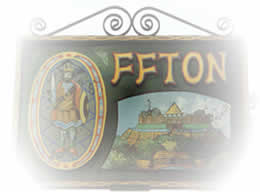
Offton and Willisham
Parish Council

Parish Council
The name OFFTON is derived from Offa's Homestead/Village or Offa's Peoples Homestead/village. There is some question about whether this is the Offa who was based in the west of England or Offa, King of the East Angles who had a castle and tomb at Hitcham.
OFFA and its derivatives were a common masculine cognomen through 500 years of Anglo Saxon times.
The suffix TON means Town and previous spellings for Offton include
Offintone
Offeton
Offinton
Offetuna
Offanton meaning Offa's farm
Offton is recorded in the Domesday Book and had two churches and two manors (Offton Castle & Offton Monks). One church (St Lawrence) was at Little Bricett and it fell into ruins in 1503.
Little Bricett was absorbed into Offton (pre 1535) and further civil boundary changes occurred in 1884 when parts of Nettlestead and Willisham were lost and parts of Elmsett and Willisham gained. The site of Little Bricett is believed to be in the region of Tollemache Hall.
Inhabited Houses were: 28 (1674); 39 (1801); 87 (1851); 84 (1871); 73 (1901); 69 (1951); 138 (1981).
Population was 27 (1086); 17 taxpayers ((1327); 18 taxpayers (1524); 86 adults inc Lt Bricett (1603); 39 households (1674); 264 inhabitants (1801); 399 inhabitants (1831); 410 inhabitants (1851); 376 inhabitants (1871); 308 inhabitants (1901); 276 inhabitants (1931); 241 inhabitants (1951); 278 inhabitants(1971); 358 inhabitants (1981).
In 1831 occupations were 66 in agriculture, 10 in retail trade, I professional, 11 in labouring and 14 in domestic service.
In 1844 occupations were: Grocer/Draper, 3 wheelwrights, cattle dealer, 2 shoemakers, blacksmith, carpenter, maltster, thatcher, victualler, farrier and 10 farmers.
In 1912 occupations were: sub-postmaster, teacher, grocer, 9 farmers, miller, wheelwright, 2 shopkeepers, blacksmith and a carpenter.
12 people attended Sunday School in 1818 and a daily school started in 1833 (15 attended). A national school was built in 1872 and 62 pupils were attending in 1891.
Records show that a public house (the Greyhound) traded between 1844 and 1891.
In 1844 occupations were 3 farmers, lime burner, bricklayer, shopkeeper, beerhouse keeper and victualler.
Click here to read about St Mary's Church